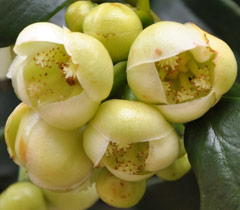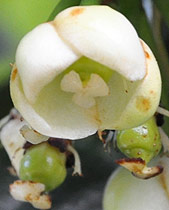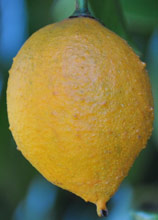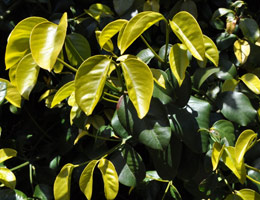Garcinia gerrardii
Garcinia gerrardii Harv. ex Sim
Family: Clusiaceae
Common names: forest garcinia, forest mangosteen (Eng.); bosgeelmelkhout (Afr.); umbande, umbindi (Xhosa); isibinda, isikhwelamfene, umbinda (Zulu); sikhwelamkhala (Siswati)
SA Tree No: 485
Introduction
Related to the mangosteen from India, the forest garcinia is not a well-known garden ornamental, but it could be. It has fragrant flowers in early summer, decorative orange fruits in winter, glossy foliage with attractive pale green new growth and it is easy to grow.

Description
Description
Garcinia gerrardii is a large shrub, 4-5 m tall, or a small evergreen tree, 10-13 m tall, with dark green, shiny, leathery, simple leaves arranged in pairs or threes. New growth is an attractive light green. The stems contain a yellow or reddish brown, sticky sap.
The flowers are borne in clusters at the tips of branches in spring-summer (September to January), and are strongly sweet-scented. They are either male or female, and are borne on separate trees. Male flowers are greenish white, rounded, 6-8 mm long and 6-7 mm wide. The stamens are grouped into four bundles, called fascicles, made up of 10-16 filaments which are free or partially united.

Female flowers are also greenish white, and much the same size as the male flowers, and contain what look like stamen bundles, but they are infertile (staminodes) and much smaller than those in the male flowers. The most obvious feature of the female flower is the large, fleshy, 3-4-lobed stigma at the tip of the relatively large ovary. The petals fall quite soon to reveal the shiny light green ovary and the staminodes.

The ovary develops into a large, rounded berry 2-3 mm long that is bright yellow-orange when ripe and contains 1 or 2 large seeds. Fruits are produced in profusion, and are ripe in late summer-winter (February to June). At Kirstenbosch, the Garcinia gerrardii plants in the Dell flower in early summer (November), and the fruits are ripe on the trees during autumn-winter (May-June-July).

Conservation Status
Status
Least Concern. Garcinia gerrardii is not threatened.
Distribution and habitat
Distribution description
Garcinia gerrardii is found in forests, in kloofs, on forest margins, sometimes on streambanks, from sea level to about 600 m, from Pondoland in the Eastern Cape, through KwaZulu-Natal to Mpumalanga and Swaziland. It is particularly common in the Egossa Forest in Pondoland and in the Ngoye Forest in Zululand.
Derivation of name and historical aspects
History
The genus Garcinia was named after of Laurent Garcin (1683-1751), a French botanist and author of many botanical works, who travelled in India. Garcinia is a large genus of about 400 species, most of which are found in tropical Asia and Africa, with only two in southern Africa. This species was named after William T. Gerrard (d.1865) an English botanical collector in KwaZulu-Natal and Madagascar in the 19th century.
Ecology
Ecology
Garcinia gerrardii fruits are eaten by birds and antelope.
Uses
Use
Garcinia gerrardii saplings and branches are used to make whips. The fruits are edible, but they are not good to eat and are not eaten by people. The bark can be used for tanning. This species is used in traditional medicine. Leaves are used to treat earache and the bark is used in sprinkling charms to prevent lightning. The root sap is effective for killing snails, and recent studies have shown rootbark to be fungicidal against Cladosporium cucumerinum.
The other Garcinia found in southern Africa is G. livingstonei¸ the African mangosteen which has delicious fruits and is also used in traditional medicine and culture.
Some of the Asian garcinias are grown commercially in some countries, e.g. Garcinia mangostana the mangosteen from Asia, known as the world's most delicious fruit. G. morella, G. hanburyi and a few other Garcinia species produce a milky yellow resinous gum that is tapped and used to make a mustard-yellow pigment called gamboge, which is used in dyes and paints, and also in some areas to dye Buddhist monks' robes. Rind of the fruit of several species, known as assam fruit, is used in flavouring curries. Some garcinias produce chewy nuts, and fruits of many of the species are eaten.

Growing Garcinia gerrardii
Grow
Garcinia gerrardii is a decorative evergreen shrub suitable for semi-shade or shade. It is easy to grow, but slow growing, which makes it more manageable and suitable for smaller gardens as well as larger gardens and parks. It also does well in containers. Grow it in a warm spot, in semi-shade or shade, in well-drained, fertile soils, and water well in spring and summer for best results.
Garcinia gerrardii is suitable for pot cultivation and with its slow growth, deep green foliage and showy fruits, it would make an interesting substitute for decorative citrus in pots. It is also a good choice for a difficult position in deep shade.
The Production Nursery at Kirstenbosch has found Garcinia gerrardii to be difficult to propagate, and slow growing, which is perhaps the reason why it has not made its way into many home gardens. Propagate by seed or cuttings. Sow fresh seed in spring or summer. Clean off the fruit and press the large seeds into the sowing medium, cover with more of the sowing medium and keep moist and warm. Take hardwood cuttings in summer, treat with rooting hormone and place under mist with bottom heat.
References
- Boon, R. 2010. Pooley's Trees of eastern South Africa. A complete guide. Flora & Fauna Publications Trust, Durban.
- Coates Palgrave, M. 2002. Keith Palgrave Trees of southern Africa, edn 3. Struik, Cape Town. Flora of southern Africa, various volumes.
- http://en.wikipedia.org/wiki/Gamboge, accessed November 2011
- Hutchings, A. 1996. Zulu medicinal plants, an inventory. University of Natal Press, Pietermaritzburg
- Leistner, O.A. (ed.). 2000. Seed plants of southern Africa: families and genera. Strelitzia 10. National Botanical Institute, Pretoria.
- Palmer, E. & Pitman, N. 1972. Trees of southern Africa. Balkema, Cape Town. Pooley, E. 1993. The complete field guide to trees of Natal, Zululand and Transkei. Natal Flora Publications Trust, Durban.
- Schmidt, E., Lotter, M. & McCleland, W. 2002. Trees and shrubs of Mpumalanga and Kruger National Park. Jacana Media.
Credits
Alice Notten
Kirstenbosch National Botanical Garden
February 2012
Plant Attributes:
Plant Type: Shrub, Tree
SA Distribution: Eastern Cape, KwaZulu-Natal, Mpumalanga
Soil type: Loam
Flowering season: Spring, Early Summer
PH:
Flower colour: White, Cream
Aspect: Shade, Morning Sun (Semi Shade), Afternoon Sun (Semi Shade)
Gardening skill: Average
Special Features:
Horticultural zones










Rate this article
Article well written and informative
Rate this plant
Is this an interesting plant?
Login to add your Comment
Back to topNot registered yet? Click here to register.